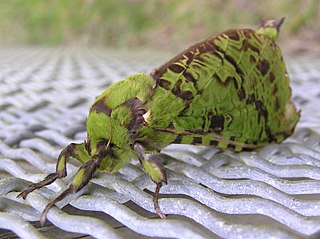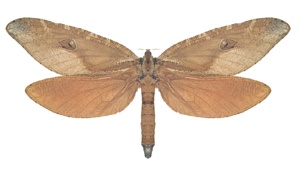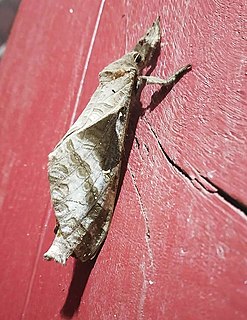Related Research Articles

Eugenia is a genus of flowering plants in the myrtle family Myrtaceae. It has a worldwide, although highly uneven, distribution in tropical and subtropical regions. The bulk of the approximately 1,100 species occur in the New World tropics, especially in the northern Andes, the Caribbean, and the Atlantic Forest of eastern Brazil. Other centers of diversity include New Caledonia and Madagascar. Many of the species that occur in the Old World have received a new classification into the genus Syzygium.

The Hepialidae are a family of insects in the lepidopteran order. Moths of this family are often referred to as swift moths or ghost moths.

Abantiades is a genus of moths of the family Hepialidae. There are 14 described species, all found exclusively in Australia. The group includes some large species with a wingspan of up to 160 mm. The larvae feed on the roots of Eucalyptus and other trees.

Aenetus is a genus of moths of the family Hepialidae. There are 24 described species found in Indonesia, New Guinea, New Caledonia, Australia and New Zealand. Most species have green or blue forewings and reddish hindwings, but some are predominantly brown or white. The larvae feed in the trunks of living trees, burrowing horizontally into the trunk, then vertically down.

Endoclita is a genus of moths of the family Hepialidae. There are 60 described species found in eastern and southeast Asia and the Indian subcontinent.

Zelotypia is a monotypic moth genus of the family Hepialidae. The only described species is Z. stacyi, the bentwing ghost moth, which is only found in Queensland and New South Wales, Australia. This is a very large species with a wingspan of up to 250 mm. The larva feeds and pupates in the trunks and branches of Eucalyptus.

The pūriri moth, also commonly called the ghost moth or pepetuna, is a species of moth of the family Hepialidae. This moth is endemic to the North Island of New Zealand. It is New Zealand's largest moth, with a wingspan of up to 150 mm. It spends the first five to six years of its life as a grub in a tree trunk, with the last 48 hours of its life as a moth. Footage has been taken of a pūriri moth chrysalis hatching over a period of one hour and forty minutes.

The map-winged swift is a moth belonging to the family Hepialidae. The species was first described by Charles De Geer in 1778. It has a patchy distribution throughout Eurasia. It was previously placed in the genus Hepialus and some references still place it there.

Abantiades latipennis, known as the Pindi moth, is a species of moth in the family Hepialidae. It may also be referred to as a swift moth or a ghost moth, as this is a common name associated with Hepialidae. Endemic to Australia and identified in 1932, it is most populous in temperate rainforest where eucalypti are prevalent, as the larvae feed primarily on the roots of these trees. Females lay eggs during flight in a scattering fashion. The larvae live for over eighteen months underground, while adult moths survive for approximately one week, as they have no mouthparts with which to feed. The moths are preyed upon by a number of predators, including bats and owls. Brown in colour overall, males are paler and the identifying silver bars of the male's wings are more prominent than those of the female's, with dark margins. Male adults are generally smaller.

Aenetus ligniveren, the common splendid ghost moth, is a moth in the family Hepialidae. It is found from southern Queensland to Tasmania.

Aenetus eximia is a moth of the family Hepialidae. It is known from southern Queensland, Australia, to Tasmania.
Endoclita auratus is a species of moth of the family Hepialidae. It is known from Myanmar. The food plants for this species are Alnus, Cryptomeria, and Eucalyptus.
Endoclita hoesi is a species of moth of the family Hepialidae. It is known from Borneo. Food plants for this species include Elettaria, Eucalyptus, and Theobroma.

Endoclita malabaricus is a species of moth of the family Hepialidae. It is known from India.
Endoclita undulifer is a species of moth of the family Hepialidae. It is known from India. Food plants for this species include Alnus, Byttneria, Callicarpa, Cryptomeria, Eucalyptus, and Gmelina.
References
- ↑ Simonsen, Thomas (2018). Splendid Ghost Moths and Their Allies: A Revision of Australian Abantiades, Oncopera, Aenetus, Archaeoaenetus and Zelotypia (Hepialidae). Csiro Publishing. ISBN 9781486307494.